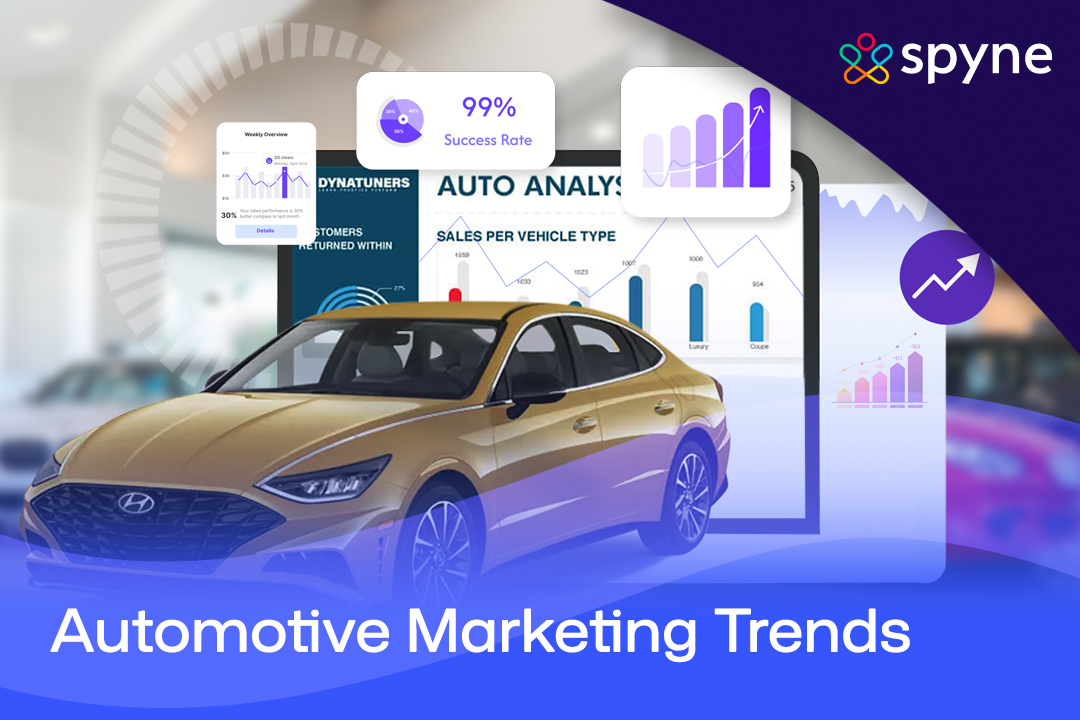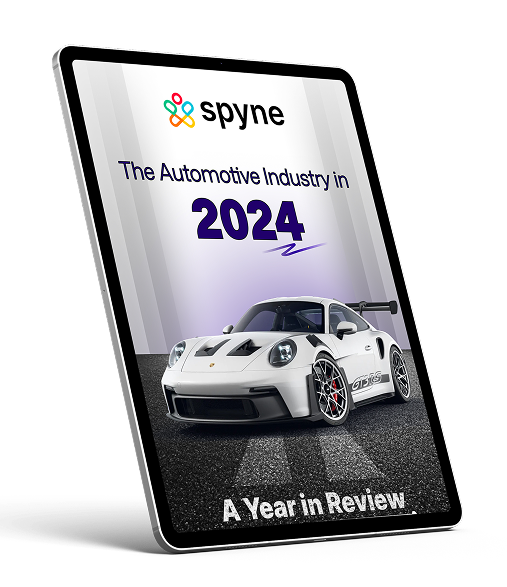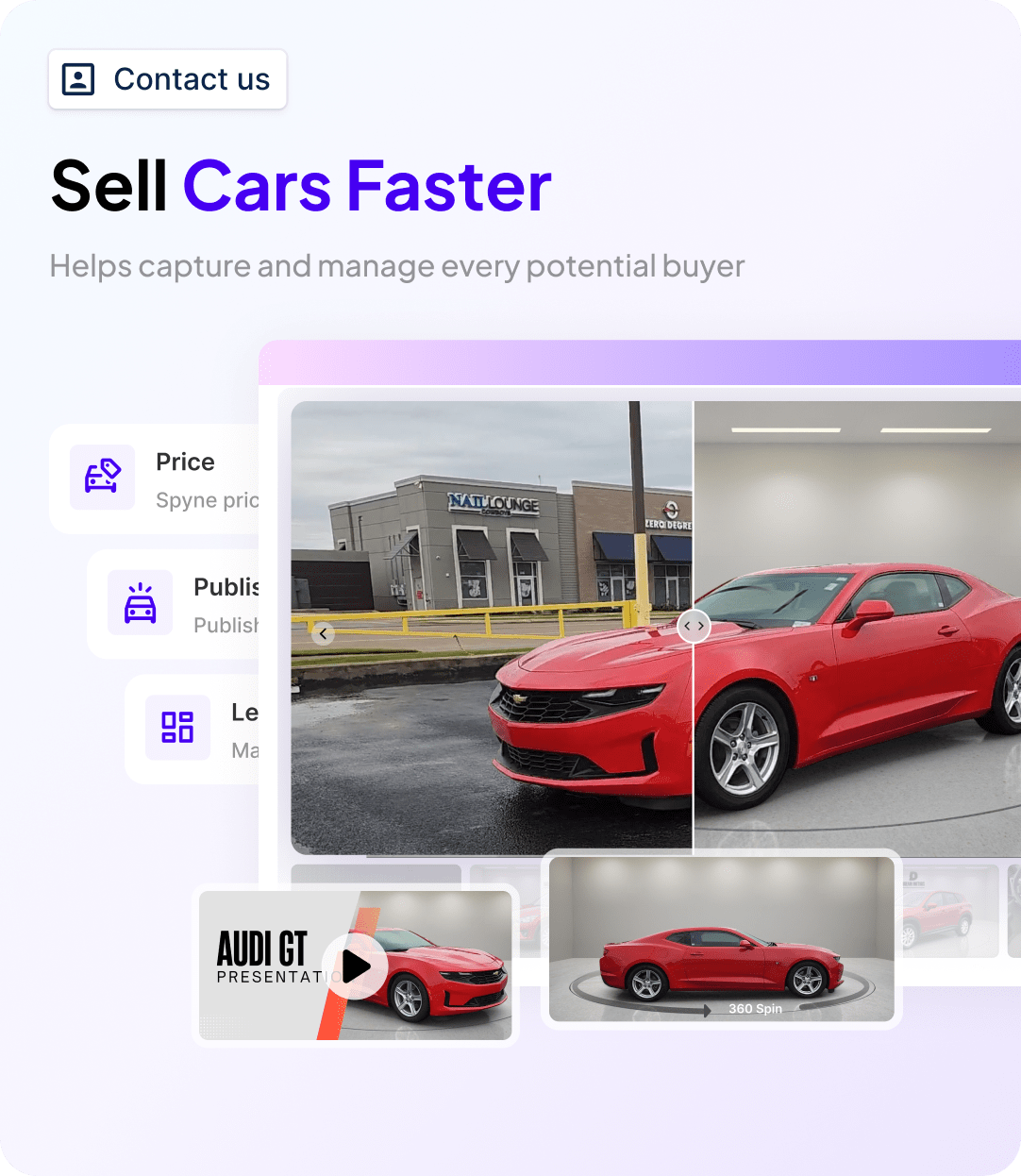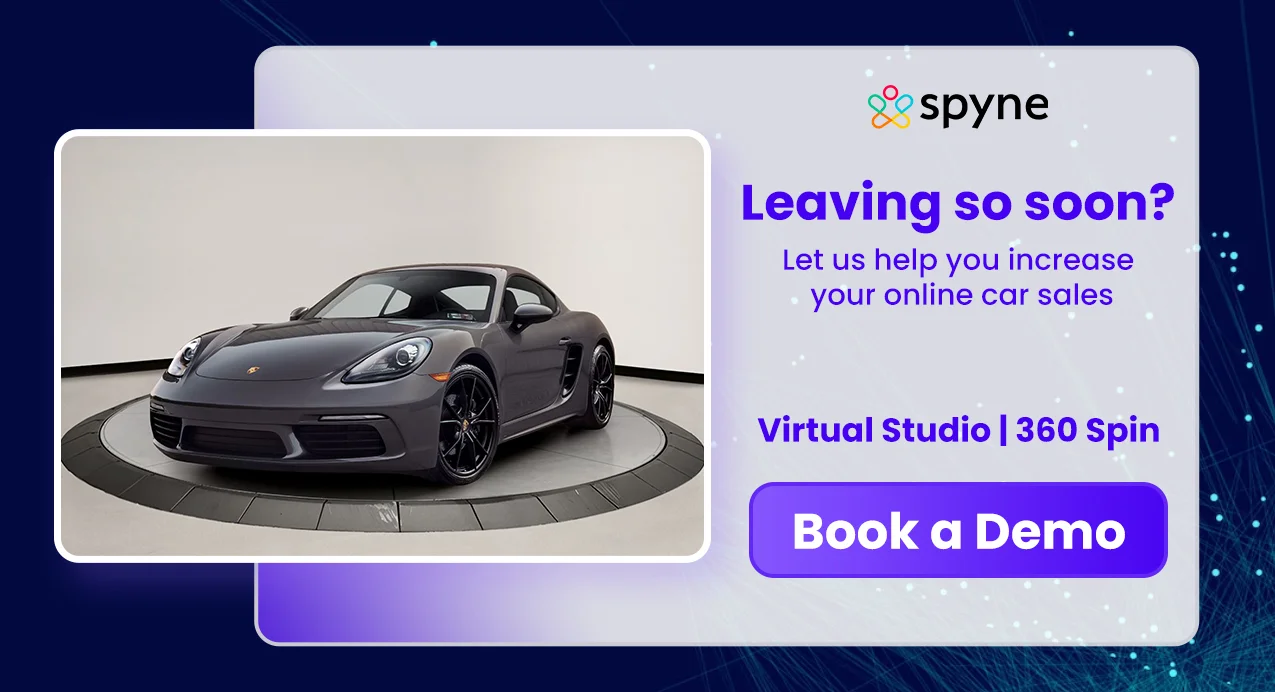Today’s car buyers move fast; they swipe, scroll, compare, and decide which car to buy long before they step into your showroom. And if your dealership’s marketing isn’t keeping up, you’re not just falling behind, you’re invisible. In 2025, selling cars isn’t just about great vehicles and offers. It’s also about great content, smart targeting, fast follow-ups, and making every click count. The dealerships that win? They’re the ones showing up in the right place, at the right time, with the right message. So if you’re tired of running the same old campaigns and seeing the same old results, this is your sign to shift gears. We’ve dissected 18 strong automotive marketing trends that are revolutionizing the game in 2025. Let’s put the pedal to the metal.
Top 18 Automotive Marketing Trends to Look Out for in 2025
Every year, we see new automotive marketing trends, tips, and tricks take over the automotive industry. Some last a couple of years, others change the industry forever. Some trends may fade away in some time, while others can last a couple of years, but one thing is clear, dealerships that are left behind end up taking a hit in terms of sales, operational efficiency, and gaining new ground. 2025 will unlock a host of such trends for the automotive market. Here are some of the latest automotive industry trends 2025:
1. AI-Driven Marketing Automation
Artificial Intelligence is revolutionizing the way dealerships do business, working smarter, not harder. AI can review huge volumes of customer data to detect patterns, forecast buying patterns, and automate campaigns. For example, AI can decide when to show an ad to a user based on their search history or send personalised emails suggesting models based on what they like.
Why it matters: AI minimizes human effort, accelerates decision-making, and maximizes ROI. Brands employing AI for predictive targeting and content creation are witnessing 30–50% accelerated lead conversions, making it a valuable car industry trend.
2. Omnichannel Marketing
Customers no longer purchase in a straight line. The average buyer will view a car advertisement on Instagram, look up reviews on Google, view a walkaround on YouTube, and then text the dealership for further information. These automotive marketing trends make sure that regardless of where the customer is, mobile, desktop, social media, or in-store, they get a similar and tailored brand experience.
Why it matters: Omnichannel dealerships with frictionless strategies are holding on to more leads and enhancing touchpoint engagement. As much as 75% of customers expect consistency across channels, making it a non-negotiable automotive market trend.
3. Visual Search and Image-Based Discovery
With Google Lens, among other tools, consumers are now able to take a picture of a car they want and look for the same car. Sites such as Pinterest and Instagram also enable discovery by image. This is an enormous opportunity for dealers to enhance vehicle listings with professional images, alt-text, and 360° views.
Why it matters: Vehicles with great-looking visuals receive more engagement. Consumers are visual thinkers, if they can’t see it, they won’t purchase it. Hence, visuals are one of the most talked-about automotive marketing trends.
4. Video Marketing is Taking the Wheel
Walkarounds, behind-the-scenes content, and short-form videos such as Instagram Reels or TikTok are essential car industry trends to grab attention. Video content enables dealerships to display their inventory in action, describe features, and establish trust with prospective buyers.
Why it’s important: Social video posts are automotive industry trends that produce more shares than combined image and text posts. A good walkaround video can say a thousand words and do a lot more than that.
5. First-Party Data is Gold
Dealerships must invest in collecting first-hand data, via newsletter signups, test-drive appointments, or CRM forms. Owning this data allows for building personalized experiences, enhanced ad targeting, and long-term loyalty, which is important, considering today’s used car market trends.
Why it matters: First-party data is more precise and privacy-friendly, resulting in improved audience segmentation and conversion measurement.
6. Connected TV (CTV) Advertising
Connected TV is seriously gaining momentum, particularly among millennials and Gen Z who’ve ditched the cable. Dealerships can now serve targeted auto ads during streaming sessions on platforms such as Hulu or Roku, targeting a more engaged and receptive audience.
Why it matters: CTV ad recall is better than traditional TV, and you can target by behavior, not demographics.
7. Hyperlocal Targeting
Geofencing and location targeting are emerging consumer trends in automotive industry that enable dealers to show ads to users within certain zip codes, at rival dealerships, or even car service facilities. This facilitates accurate automotive marketing ROI like never before.
Why it matters: Hyperlocal campaigns minimize wastage and drive more footfall, particularly during local promotions or festive campaigns, making it one of the ideal current automotive marketing trends to follow.
8. Personalization Across Touchpoints
Personalization is not merely putting the customer’s name in emails. It is customized car suggestions based on browsing history, dynamic website content, and follow-up offers on past interactions. With Spyne’s Connect.ai CRM, every customer interaction is tailored, whether it’s AI-powered car recommendations based on browsing history, automated follow-ups triggered by past inquiries, or dynamic content tailored to their buying stage. Spyn’s CRM captures customer behavior across web, form, and call touchpoints to deliver smart messaging with timely nudges, creating a more relevant, human sales experience.
Why it matters: Personalized experiences are among the most sought-after auto market trends that can boost conversion rates by improving lead engagement and accelerating decision-making.
9. Native Ads for a Non-Intrusive Experience
Rather than splashy banner advertisements, dealerships are employing automotive market trends like native automotive advertising that flows with content streams. For example, sponsored blogs, suggested car lists, and TikTok advertising that appear to be standard posts are actively used.
Why it matters: Native advertising sees greater view-throughs and leads to more engaging interactions compared to display advertising.
10. In-House Digital Retailing Platforms
Dealerships are embracing technologies that allow shoppers to do much of the car-buying process online, including inventory shopping, financing, trade-ins, and even final pricing, all from home.
Why it matters: 70% of customers want to finish part of the purchase online. Dealerships with full digital retailing capabilities have quicker deal closures and more satisfied customers.
11. Social Commerce is on the Rise
These platforms are no longer just for awareness. Now, they’re becoming eCommerce platforms. Facebook Marketplace is already a popular spot for used vehicles, and now newer tools enable users to begin the buying process directly through DMs or in-line CTAs.
Why it matters: Social commerce combines entertainment with action, accelerating decision-making for impulse shoppers.
12. Sustainability and EV-Centric Messaging
As EVs become more popular, marketing messages must shift from horsepower to charging speed, range, and environmental footprint. Dealerships need to get on board with such current automotive trends to target sustainability-minded buyers by emphasizing green programs and energy-efficient models.
Why it matters: Gen Z consumers are more likely to purchase from environmentally responsible brands.
13. User-Generated Content (UGC) for Authenticity
Car buyers trust other buyers. Encouraging customers to post about their new purchase, tag the dealership, or share their experience can create a snowball effect of trust and visibility.
Why it matters: Among many automotive marketing trends, UGC content sees higher click-through rates and builds stronger community credibility.
14. Voice Search Optimization
“Hey Siri, locate used SUVs close to my location”- Voice search is exploding, particularly with smart home devices and mobile devices. It’s essential to optimize your listings and website for voice searches, such as FAQs and conversational terms.
Why it matters: Voice search is now responsible for 30% of all mobile searches, particularly in local car-purchase situations.
15. Real-Time Engagement Tools
Live chat, WhatsApp integrations, and Facebook Messenger bots enable dealerships to respond to buyer inquiries instantly, quite literally the difference between a hot lead and a lost one.
Why it matters: Dealerships responding within 5 minutes are more likely to close a lead.
16. Influencer & Micro-Influencer Collaborations
Car buyers believe peer recommendations more than celebrity endorsements. Micro-influencers in local car critics, mechanics, or lifestyle vloggers can provide targeted campaigns with credibility.
Why it matters: Influencer campaigns produce more ROI compared to traditional display ads.
17. Inventory-Focused Ad Strategies
Some dealerships are linear in their marketing approach. They don’t analyse the latest automotive marketing trends and are limited to blanket banner ads with “Huge Sale!”. This old-school method is dated and no longer works. Dealerships today are spending money on dynamic inventory ads with current availability, price, and location of individual models, which helps you showcase their inventory and sell the lifestyle.
Why it matters: These car dealership ads are leading automotive industry market trends, providing a sense of urgency and enabling more targeted customer selection, particularly for sale or limited-production models.
18. Augmented Reality (AR) Showrooms
AR enables consumers to “place” a car on their driveway, see interiors, or try various colors, all on their smartphone. This virtual experience builds confidence and enthusiasm into the buying process.
Why it matters: AR boosts conversion rates by as much as 40% by mitigating buyer doubt and enhancing product comprehension.
Embracing these automotive marketing trends will help your dealership understand its customers better, follow them on the right platforms and channels, and engage them better. This will result in high sales, happier customers, and a thriving dealership.
How Spyne’s AI-Powered Solutions Help Car Dealerships Increase Sales and Boost Efficiency
Spyne’s retail AI solution for the automotive industry is specially designed to address the different needs and pain points of dealerships. From sourcing to pricing, marketing, and selling vehicles seamlessly, the company’s tools and features allow you to enhance your dealership’s performance and increase sales. Here’s how Spyne helps your dealership grow:
1. Efficient Vehicle Sourcing and Inventory Management
Spyne’s automotive inventory management gives you insights into the marketplaces to source your cars from and provides you with real-time updates on pricing changes and customer buying patterns. This helps you know who to target, the best-selling cars to add to your inventory, saves time, and facilitates quicker inventory turnover, as well as an improved sales cycle.
2. Autoweb AI for No-Code Website Building
Research indicates that 75% of customers judge a company’s credibility by its website design. Spyne’s Autoweb AI enables you to create a professional, mobile-friendly website. With no technical or coding expertise needed, choose from over 100 design templates and drag and drop the pages you want in your website. With personalized templates, real-time inventory synchronization, in-built SEO tools, and engaging design, dealerships can build a car dealer website that is both engaging and appealing to their audience.
3. More Detailed Online Listings
Spyne’s computer-optimized imaging technology enhances photo quality and reduces load time, two important drivers that impact the performance of listings online. Pages that load faster, have lower bounce rates, and are more visible in search engines. And Spyne’s automotive marketing solutions ensure that every vehicle displayed looks highly attractive and image-optimized to boost inquiries and conversions.
4. Marketing Platform Integration
Spyne solutions integrate smoothly with multiple marketing platforms, ensuring consistent branding and messaging across all channels. Such a harmonious method promotes brand recognition, credibility, and helps embrace more automotive marketing trends. Spyne’s Facebook Marketplace integration for efficient listings promotion and automotive marketing strategies will help your dealership bank on some of the most valuable automotive industry trends 2030, enhancing your market presence and ultimately boosting sales.
5. Automotive CRM For Lead Management and Recovery
Spyne’s automotive CRM, Connect.ai, helps you track high-intent customers from many different channels, prioritize, and follow up on cold leads with automated calls. With call tracking intelligence and continuous 24/7 customer conversations, every lead is monitored, followed up on, and converted into a sale, so no opportunity falls through the cracks.
6. Studio-Quality Visuals Powered by AI
Spyne’s Studio AI solution enables dealerships to create studio-grade images and videos for their car fleet using AI technology. This makes your vehicle listings look great, grabbing the attention of potential customers and hence increasing interest and sales. The automotive digital marketing solution uses AI to transform raw photos taken with a mobile camera into more visually appealing images with great backgrounds, compelling angles, and even 360-degree video tours.
Conclusion
The future of the automotive sector is evolving rapidly, with digitalization and personalized experiences at the helm. To remain ahead of the curve, car dealerships need to adopt these automotive marketing trends and use innovative solutions. Spyne provides AI-powered tools and know-how to revolutionize your dealership’s marketing strategy, boosting engagement and sales. Join the future of automotive marketing with Spyne and drive your dealership to unprecedented success.
















